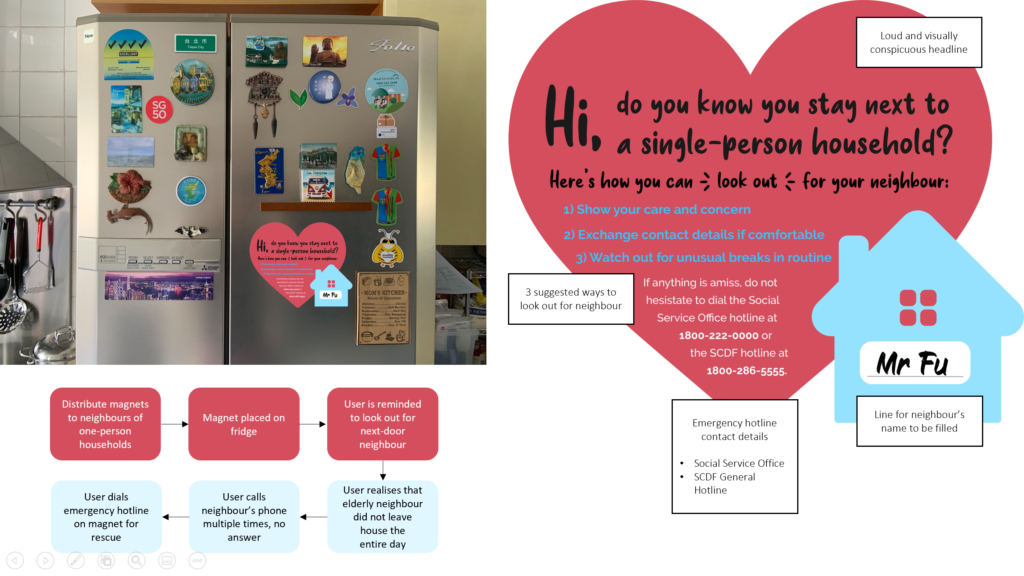
Design Challenge
#2: How might we encourage our community to support one another and look out for those who are socially isolated?
Project Description
In Singapore, there has been a rise in cases recorded and reported of isolated elderly dying alone in their flats without neighbours knowing for an extended period. During the extended COVID-19 circuit breaker period, such single-person households are even more at risk of being isolated and forgotten. My design aims to reduce these occurrences and promote the resurgence of community awareness, especially among neighbours of single-person households. My hope is that through a simple and feasible initiative, Singaporeans will be encouraged to look out more for one another in their housing vicinity.
Criteria #1: Value
When we think about caring for the well-being of elderly neighbours who are living alone, perhaps we would think of installing monitoring devices to track and report their movements. Indeed, according to a Channel News Asia article, HDB introduced a monitoring and alert system in 2014 in several estates that could learn the seniors’ movements and report anomalies, as part of a trial. Yet this initiative lost its popularity when elderly refused to be monitored. We have to respect the dignity and privacy of our beneficiaries in our solutions – technology may not be the best substitute for the community spirit.
Criteria #2: Inspiration
Upon realising nothing beats the genuine care and concern of a loving neighbour, how do we encourage Singaporeans to demonstrate it? With our busy schedules, it’s easy to forget about people other than ourselves or our immediate family. In our nation, there exists the habit of collecting magnets and dotting our refrigerators with these colourful tokens. Housewives open the fridge daily to prepare meals. Children open the fridge to search for their favourite snack. Even workaholics open the fridge to grab a can of beer after a long, hard day at work. Simply put, the fridge is a conspicuous place.
Criteria #3: Impact
Working in collaboration with social service organisations and volunteer welfare organisations, these fridge magnets will be distributed in a targeted manner to the neighbours of single-person households of all ages. This initiative can be developed into multiple volunteer events in order to match its scale, where volunteers go door-to-door to neighbours of vulnerable households island-wide, explaining the cause and gifting the magnet. I believe that this initiative has low barriers to adoption (receiving households just need to place magnet on fridge) but it could go a long way in keeping the wellbeing of their single-household neighbours relevant in their minds.
Criteria #4: Timeliness
While this initiative is unlikely to be implemented during the circuit breaker period, the production of the magnets can be started. Government or NCSS grants are likely to be available to offset the costs of optimizing the design of the magnet as well as costs of production. When the circuit breaker is lifted in June, we can collaborate with volunteer organisations to kickstart the distribution island wide.
Criteria #5: Systems Thinking
The Department of Statistics estimates that 83,000 elderly persons will be living alone by 2030. With tragic reports in recent years of elderly dying alone, Good Samaritans and government have stepped forward to sponsor CCTVs for elderly willing to be monitored. Unfortunately, there has yet to be a campaign on the wider community front to spread awareness on the issue.
Fortunately, Singapore has a strong network of social services and charities which have established tight links with the aged, such as TOUCH, Feiyue and THK Moral Charities whom we can begin to work with to identify vulnerable single-person elderly households.


